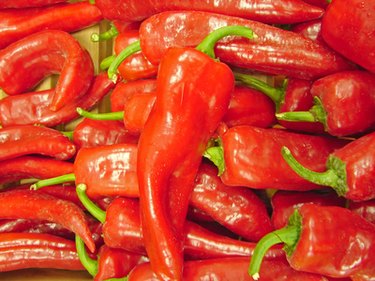Things You'll Need
Latex gloves
Chili pepper extract
Water
Sugar
5 panel members
Dried, ground chili pepper pods
High performance liquid chromatograph machine
Visual guide of Scoville rating scale

The Scoville Rating Scale is used to determine the pungency, or spiciness of foods, particularly chili peppers. The scale was developed in 1912 by Wilbur Scoville, a chemist who worked at the Parke-Davis pharmaceutical company. The scale measures the amount of capsaicin in a pepper, ranging from no capsaicin (a bell pepper) to 16,0000 Scoville Units (SU), which is pure capsaicin. The hottest pepper known, the Bhut Jolokia or Naga Jolokia, tops out at 1,050,000. Capsaicin (8-methyl N-vanillyl 6-nonenamide) is the active chemical in chili peppers. It also is used the active ingredient in the pepper spray used by law enforcement and in self defense. Law enforcement-grade pepper spray has between 5,000,000 and 5,300,000 SU.
Determining Scoville Units
Step 1
Purchase chili pepper extracts online or in specialty stores. The extraction of capsaicin is a difficult and potentially noxious process that involves chemical analysis, and it is best not to try making extract at home.
Video of the Day
Step 2
Dissolve sugar in water and add extract.
Step 3
Give sample to panel members for tasting. Count the number who can taste the pungency. Continue diluting the solution until a certain number of panelists, generally three of five, can agree on the taste.
Step 4
Dilute the sugar-water solution and continue until no one tastes the pungency. This determines the SU. The more water that is required, the hotter the pepper and the higher the Scoville Rating Scale.
Determining ATSA Pungency Units
Step 1
Use a High Performance Liquid Chromatograph machine to determine ASTA units. The machine is used because many scientists, including those from the American Spice Trade Association (ASTA) and the International Organisation for Standardisation, felt the Scoville method, which relied on the tastes of individuals, was too subjective and unreliable. High Performance Liquid Chromatograph machines are available through pharmaceutical and chemical analysis companies.
Step 2
Place dried, ground pods into the machine, which is as sensitive as tastebuds to pungency but more reliable. This determines ATSA units, which are based on parts per million (ppm), or about 15 Scoville units.
Step 3
Multiply each ASTA unit by 15 to find the number of Scoville units and report them as SUs as many people look to the older scale for an indication of heat in chilies.
Tip
Most people who aren’t chemists do not calculate Scoville units. They do, however, like to know how hot a pepper might be. This can be done by comparing the chili’s appearance to a visual guide of the Scoville Rating Scale.
Warning
If you do try to calculate Scoville heat anywhere other than in a laboratory, make sure you wear latex gloves.
Video of the Day